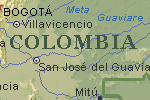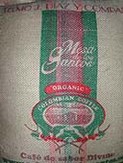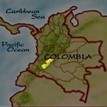Main menu:
Columbia
Introduction |
||||||||||||
Flag: |
|
|||||||||||
Card: |
|
|||||||||||
Background: |
Colombia was one of the three countries that emerged from the collapse of Gran Colombia in 1830 (the others being Ecuador and Venezuela). A 40-year insurgent campaign to overthrow the Colombian Government escalated during the 1990s, undergirded in part by funds from the drug trade. Although the violence is deadly and large swaths of the countryside are under guerrilla influence, the movement lacks the military strength or popular support necessary to overthrow the government. While Bogota continues to try to negotiate a settlement, neighboring countries worry about the violence spilling over their borders. |
|||||||||||
Geography |
||||||||||||
Location: |
Northern South America, bordering the Caribbean Sea, between Panama and Venezuela, and bordering the North Pacific Ocean, between Ecuador and Panama |
|||||||||||
Geographic coordinates: |
4 00 N, 72 00 W |
|||||||||||
Map references: |
South America, Central America and the Caribbean |
|||||||||||
Area: |
total: 1,138,910 sq kmland: 1,038,700 sq kmwater: 100,210 sq kmnote: includes Isla de Malpelo, Roncador Cay, Serrana Bank, and Serranilla Bank |
|||||||||||
Land boundaries: |
total: 6,004 km |
|||||||||||
Coastline: |
3,208 km (Caribbean Sea 1,760 km, North Pacific Ocean 1,448 km) |
|||||||||||
Maritime claims: |
continental shelf: 200-m depth or to the depth of exploitation |
|||||||||||
Climate: |
tropical along coast and eastern plains; cooler in highlands |
|||||||||||
Terrain: |
flat coastal lowlands, central highlands, high Andes Mountains, eastern lowland plains |
|||||||||||
Elevation extremes: |
lowest point: Pacific Ocean 0 m |
|||||||||||
Natural resources: |
petroleum, natural gas, coal, iron ore, nickel, gold, copper, emeralds, hydropower |
|||||||||||
Geography - note: |
only South American country with coastlines on both North Pacific Ocean and Caribbean Sea |
|||||||||||
Government |
||||||||||||
Country name: |
conventional long form: Republic of Colombia |
|||||||||||
Government type: |
republic; executive branch dominates government structure |
|||||||||||
Capital: |
Bogota |
|||||||||||
Flag description: |
three horizontal bands of yellow (top, double-width), blue, and red; similar to the flag of Ecuador, which is longer and bears the Ecuadorian coat of arms superimposed in the center |
|||||||||||
Economy |
||||||||||||
Economy - overview: |
Colombia is poised for muted growth in the next several years, marking continued recovery from the severe 1999 recession when GDP fell by about 4%. President PASTRANA's well-respected economic team is working to keep the economy on track, maintaining low interest rates, for example. In accordance with its IMF loan agreement, the administration also is taking steps to improve the public sector's fiscal health. However, many challenges to improved prosperity remain. Unemployment was stuck at a record 20% in 2000, contributing to the extreme inequality in income distribution. Two of Colombia's leading exports, oil and coffee, face an uncertain future; new exploration is needed to offset declining oil production, while coffee harvests and prices are depressed. The lack of public security is a key concern for investors, making progress in the government's peace negotiations with insurgent groups an important driver of economic performance. Colombia is looking for continued support from the international community to boost economic and peace prospects. |
|||||||||||
Agriculture - products: |
coffee, cut flowers, bananas, rice, tobacco, corn, sugarcane, cocoa beans, oilseed, vegetables; forest products; shrimp |
|||||||||||
Exports: |
$14.5 billion (f.o.b., 2000 est.) |
|||||||||||
Exports - commodities: |
petroleum, coffee, coal, apparel, bananas, cut flowers |
|||||||||||
Currency: |
Colombian peso (COP) |
|||||||||||
Currency code: |
COP |
|||||||||||
Transportation |
||||||||||||
Ports and harbors |
Bahia de Portete, Baranquilla, Buenaventura, Cartagena, Leticia, Puerto Bolivar, San Andres, Santa Marta, Tumaco, Turbo |
|||||||||||
Coffee |
||||||||||||
|
||||||||||||
The Primary Growing Regions of Colombia: |
||||||||||||
|
|
|
|
|||||||||
|
|
|
||||||||||
A note on Colombian selections: Coffee from Colombia comes in all grades to suit different markets: there are lower grades for commercial and food service applications, generic medium grades, Speciality grades, and at highest end of the spectrum there are specific appellations with designated varietal and farm or micro-region. The later has only become available in the last two years or so (before that many fine coffees were pooled with not-so-fine lots to form large exportable shipments). This means that the marginally Speciality grades, pooled lots designated only by a general region like Huila, Medellin, Antioquia, Popayan, etc. no longer represent the best of Colombian coffee. These lots can be okay, but recent samples have showed a tendency toward the aqua-pulp rapid milling process. The use of non-traditional varietals like Variedad Colombian is also a trend towards higher production detrimental to cup quality. Our response is to carry the best Colombians we can find, traditional varietals, farm and micro-regional lots, special selections. I'll certainly cup the other lots too and if there's something good we'll get it. |
||||||||||||
"Usual Good Quality" Colombian Excelso" |
||||||||||||
Imperfections are based on a volume of 36 cubic inches (the contents of a cylinder 4" in diameter and 2 7/8" high or rectangular container of approximately 7 1/2" length X 4 1/2" width X 1 1/8" height). Colombian Excelso Coffee shall be understood to be of the crop which is current at the time of shipment. |
||||||||||||
exeples of defects |
Schedule of Imperfections |
Total |
||||||||||
|
|
|
|
1 Full Black |
1 defect |
|||||||
|
|
|
|
5 Broken or Cut beans |
1 defect |
|||||||
|
|
|
|
3 Small Sticks |
1 defect |
|||||||
|
|
|
|
3 Small Stones |
1 defect |
|||||||
Screen Supremo 18 |
||||||||||||
Region: |
Huila |
|||||||||||
defects: |
0 def/300gr, 18 Screen |
|||||||||||
Crop: 12-'13 |
|
|||||||||||
Full City Roast: |
The cup can be a bit sour at the light end of city, and definitely holds up to a heavier roast. In fact, this cup is excellent well into the Light French stages. |
|||||||||||
Compare to: |
A great cup by any measure, with the fruity flavors often found in Bucaramangas (like the Mesa de los Santos) and an overall "spice tea"-like cup character. |
|||||||||||
Qualities: |
washed classified as per screensize (Supremo or Excelso) and per preparation European prep and USA prep. |
|||||||||||
Altitude: |
800 to 1.900 Meter |
|||||||||||
Harvest: |
main crop: from April to June small crop: October to January |
|||||||||||
Shippingperiod: |
practically all year long |
|||||||||||
Port of Export: |
Buenaventura, Santa Marta, Cartagena |
|||||||||||
Shipment: |
in container in bags (of 250 of 70,- kos net) or bulk 20.7 tons |
|||||||||||
Production: |
abt. 14 Mio bags |
|||||||||||
Export figures: |
abt. 8.5 Mio bags |
|||||||||||
Special remarks: |
suitable for all blends |
|||||||||||
Summery: |
1st world producer for washed Arabica |
|||||||||||
Caffeine content: |
1.37% |
|||||||||||






































